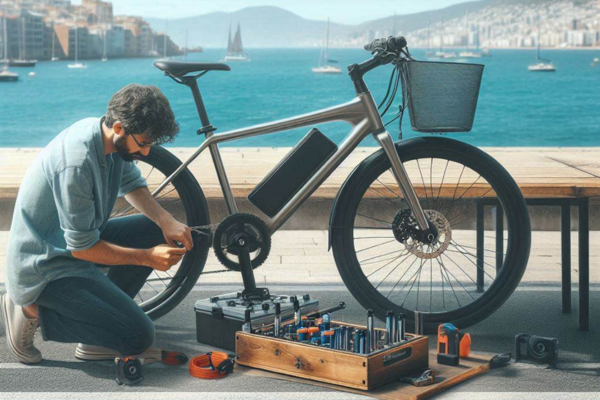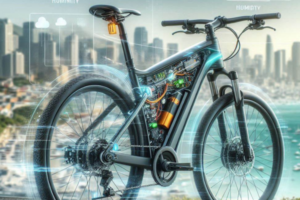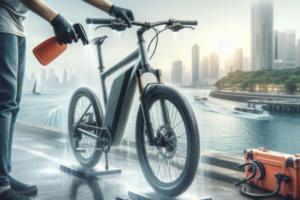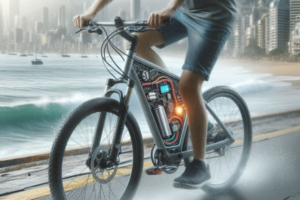Maintenance Strategies to Maximize Energy Efficiency in Humid Environments
🌧️ Why Humid Environments Demand a Different E-Bike Maintenance Approach
Electric bicycles are designed to be efficient, eco-friendly, and relatively low-maintenance — but these qualities can be compromised quickly in humid climates. Whether you live in a coastal city or a tropical region with high year-round humidity, your e-bike is constantly exposed to moisture in the air that can quietly reduce its energy efficiency, wear down key components, and shorten its lifespan.
Unlike visible rain or mud splashes, humidity is often invisible — it clings to surfaces, seeps into moving parts, and accumulates inside delicate electrical areas. Over time, this can lead to increased rolling resistance, power leakage in motor systems, drivetrain inefficiencies, and more frequent battery drain. The result? Your e-bike consumes more energy to do the same amount of work, reducing your range and increasing long-term costs.
Understanding how to maintain your e-bike with humidity in mind isn’t just a matter of preventing rust — it’s about protecting your energy efficiency and riding experience. In this article, we’ll explore proven strategies to help you ride smarter, reduce energy loss, and extend the performance of your e-bike, no matter how damp your surroundings may be.
⚙️ How Humidity Disrupts E-Bike Performance and Efficiency
Before diving into solutions, it’s important to understand the specific ways in which high humidity affects your e-bike’s systems. Even without direct rain exposure, moisture in the air creates conditions that promote oxidation, conductivity issues, and mechanical resistance.
- Drivetrain Friction: Chains, derailleurs, and cassettes accumulate a mix of moisture and airborne dirt, forming a thin layer of grime that increases resistance. This means the motor must exert more energy, even during flat rides.
- Electrical Inefficiencies: Tiny droplets of condensation in battery ports or around control units can interfere with signal transmission, causing voltage drops and miscommunication between components. Your bike “works harder” to function.
- Brake Drag: Disc brakes and pads are vulnerable to light rust and sticky surfaces. This subtle drag increases rolling resistance and consumes more energy without you even noticing.
- Underinflated Tires: Changes in air pressure due to temperature and humidity fluctuations often go unnoticed, but lower PSI means increased contact with the ground — and more battery drain.
Each of these factors may seem minor on its own, but together they create a cascade effect that can reduce energy efficiency by 10–20%. That’s the difference between getting to your destination confidently or anxiously watching your battery percentage drop too quickly.
💭 A Powerful Reminder
“In humid weather, a silent bolt or an unseen drop of moisture can take more power than a steep hill. Energy efficiency begins with attention to the invisible.”
The truth is, efficient riding doesn’t begin with the motor or the battery. It begins with smart, climate-conscious maintenance. Riders in humid regions face a unique set of challenges — but with knowledge, awareness, and routine care, those challenges can become manageable and even empowering.
In the next sections, we’ll uncover the most effective maintenance strategies tailored specifically for humid environments. From chain care to battery protection, you’ll learn how to make small, intentional changes that have a big impact on your e-bike’s energy performance.
🧰 Strategic Maintenance: Where Energy Efficiency Begins
Once you understand how humidity affects the performance of your electric bicycle, the next step is building a maintenance plan that actively combats these effects. Many riders assume that maintenance is only necessary when parts begin to fail — but in humid environments, preventive care is not optional, it’s essential.
Proper maintenance in high-humidity regions must be frequent, focused, and climate-aware. Every small intervention — from wiping a cable to lubricating a chain — plays a role in keeping your motor, battery, and drivetrain from overworking and wasting precious energy.
🔧 Weekly Maintenance Routine for Humid Conditions
Here is a highly recommended weekly routine for e-bike riders living in humid cities or coastal regions. These tasks don’t take long but have a powerful cumulative effect on energy efficiency:
- 🧼 Clean the frame and motor housing with a microfiber cloth to remove salt particles and condensation buildup.
- 🛢️ Degrease and lubricate the chain using a wet-condition lube designed to repel moisture and prevent grime buildup.
- 🔋 Inspect the battery and charging port for signs of corrosion or moisture — clean gently with a dry cloth if needed.
- 📏 Check and correct tire pressure to ensure optimal rolling resistance. Temperature swings in humid climates affect PSI more than you think.
- 🛑 Test the brakes to detect light dragging or squeaking. If found, clean rotors with alcohol wipes and ensure pads are dry and properly aligned.
- ⚡ Run a short performance check on motor responsiveness and battery range to catch changes early.
Each of these steps helps eliminate hidden energy losses. Your motor won’t have to fight against resistance, your battery will deliver power more efficiently, and your entire ride will feel smoother and lighter.
📊 Comparison Table: Humid vs. Dry Environment Maintenance
| Maintenance Task | Dry Climate | Humid Climate |
|---|---|---|
| Chain lubrication | Bi-weekly or monthly | Weekly with wet-condition lube |
| Battery inspection | Monthly | Weekly and after rides in heavy moisture |
| Brake check | Monthly | Every 7–10 days |
| Tire pressure adjustment | Every 2 weeks | Weekly or after rain/humidity swings |
💡 Energy Tip
“The easiest way to extend your battery range is to eliminate the tiny inefficiencies you don’t see. Clean chains. Dry connectors. Balanced tires. That’s where energy is won or lost.”
By integrating this routine into your weekly schedule, you’ll not only save energy — you’ll preserve the smoothness, silence, and strength of your ride. Think of it not as maintenance, but as a weekly recharge for your entire e-bike system.
🌍 Real Case: A Humid City and a Shortened Ride
Luis lives in Barranquilla, Colombia — a humid coastal city where temperatures rarely drop below 25°C and humidity often sits above 80%. When he purchased his first electric bicycle, he expected at least 50 km of range based on the manufacturer’s specs. But after two months of daily riding, he was barely reaching 35 km per charge, even without hills or extra cargo.
Initially, he thought the battery was faulty. But after visiting a technician, it was clear that the issue was not the battery — it was the environment. His chain was nearly dry and coated with grime. The disc brakes were slightly rusted, causing a drag effect. His tires were underinflated due to temperature fluctuations, and light condensation was found around the motor cable port. The result was a perfect storm of small inefficiencies adding up to big energy waste.
After implementing a customized humidity-aware maintenance routine, Luis recovered nearly 12 km of range in just two weeks. The ride became smoother, the motor quieter, and the battery stopped overheating. His story is not unique — it’s common in coastal cities. But it shows what’s possible when riders understand the true cost of moisture and take action.
✅ Smart Upgrades to Boost Energy Efficiency in Humid Environments
Beyond routine maintenance, there are small but powerful upgrades you can make to better equip your e-bike for humid climates. These changes may require an initial investment, but the long-term savings in energy, battery life, and repair costs can be substantial.
- 🛠️ Stainless steel components: Upgrade bolts, brake rotors, and exposed screws to stainless steel to resist corrosion and ensure smoother mechanical operation.
- 💧 Dielectric grease for connectors: This non-conductive grease protects electrical connectors from corrosion and moisture without interrupting current flow.
- 🧴 Wet-condition chain lubricant: Specially designed to resist water, this lube prevents rust and reduces drivetrain friction even in constant humidity.
- 🛡️ Silicone sealant or frame protectant: Applying a breathable, water-repelling coating can help protect paint, frames, and electrical enclosures.
- 🔋 Ventilated battery storage case: For those who remove their battery at night, a ventilated, dry container prevents condensation and preserves battery health.
Each of these upgrades is relatively low-cost and can dramatically improve the durability and efficiency of your e-bike’s most vulnerable components. They’re not just about protecting your ride — they’re about protecting your energy output and your peace of mind.
💬 Empowering Insight
“In humid cities, an unprotected e-bike slowly works against itself. But with the right tools and attention, you can turn resistance into resilience — and wasted energy into smooth, silent distance.”
Riding efficiently in a humid environment is absolutely possible. It doesn’t take fancy equipment — it takes strategy, observation, and smart upgrades. By staying one step ahead of moisture, you give your e-bike the conditions it needs to perform at its best.
🚫 Common Mistakes That Drain Energy in Humid Climates
Even the most well-intentioned e-bike riders can fall into habits that unintentionally reduce their energy efficiency — especially when they don’t realize how their environment impacts performance. In humid climates, small oversights lead to big losses. Let’s explore some of the most common mistakes and how to avoid them:
- ❌ Infrequent lubrication: Humidity wears down lubricants faster than dry air. If you apply chain oil once a month — or worse, less — friction builds up, causing the motor to compensate by drawing more power.
- ❌ Storing the e-bike outdoors under plastic covers: While it may seem protective, non-breathable covers trap moisture inside. The result? A warm, damp environment that speeds up corrosion and creates condensation in electrical components.
- ❌ Ignoring small noises or resistance: A slightly sticky brake, a faint creaking chain, or mild drag might seem harmless. But in humid conditions, these signs often mean growing resistance — and growing battery drain.
- ❌ Charging the battery immediately after wet rides: Plugging in a warm, damp battery without letting it dry first can increase internal condensation risk and reduce charging efficiency over time.
- ❌ Using generic maintenance schedules: What works in dry cities won’t always work in coastal or tropical ones. Humid environments need a different rhythm of care — more frequent, more gentle, more observant.
By addressing these common missteps, you can quickly recover lost efficiency and extend the life of both your battery and your ride. Think of each fix not as a chore — but as a recovery of energy you were unknowingly giving away.
📋 Energy-Saving Checklist for Humid-Riding E-Bike Owners
This quick checklist condenses all of the strategies discussed so far into one weekly habit-building guide. Print it, save it, or set it as a reminder. These small steps add up to major gains:
- 🔋 Inspect and dry the battery and ports before and after charging.
- 🛢️ Lubricate the chain weekly with wet-condition lube.
- 💨 Wipe down exposed metal parts (bolts, levers, gears) after every ride.
- 🧽 Clean and dry brake rotors and pads to prevent drag buildup.
- 📏 Maintain correct tire pressure, especially after temperature swings.
- 📦 Store the bike in a ventilated, covered space — not under sealed plastic.
- 🧪 Check for corrosion signs monthly: connectors, bolts, frame joints.
This isn’t just about preserving your bike. It’s about preserving your power — physical, electrical, and emotional. Smooth riding begins with a well-tended machine.
💡 Smart Reminder
“Efficiency isn’t only about technology — it’s about consistency. The best riders are not the fastest, but the most attentive.”
You don’t need to be a technician to maintain energy efficiency in humidity. You just need awareness, the right tools, and a few routines done with love. When you care for your e-bike, it gives that care right back in range, performance, and joy on the road.
❓ Frequently Asked Questions (FAQs)
Can I wash my e-bike if I live in a humid environment?
Yes, but avoid using high-pressure water. Instead, use a damp cloth or sponge and dry the bike thoroughly afterwards — especially around the motor, battery, and connectors. In humid climates, any extra moisture left behind may speed up corrosion or affect electrical performance.
How often should I lubricate my chain in a humid area?
Once a week is ideal. Even if you don’t ride every day, moisture in the air breaks down lubrication faster. Use a wet-condition chain lube for best results and apply after cleaning the chain to avoid sealing in dirt.
Is storing the battery indoors really necessary?
Yes — especially in high-humidity or coastal areas. Battery ports and connectors are vulnerable to internal condensation. Storing the battery in a cool, dry, ventilated space greatly extends its life and ensures better energy delivery.
What signs indicate that humidity is affecting my e-bike?
Watch for increased battery drain, strange motor noises, reduced range, rust on bolts or discs, and sticky chain behavior. If your ride feels “heavier” or your battery drains faster than expected, it’s time for a humidity inspection.
Do protective sprays actually help?
Yes. Silicone-based frame sprays and dielectric grease for connectors are excellent tools to form a barrier against moisture without affecting performance. Just make sure to use products approved for e-bike components.
💬 Final Thoughts
Living and riding in a humid environment doesn’t mean accepting a slow, inefficient, or short-lived electric bicycle. Quite the opposite — it’s an opportunity to become a more attentive, empowered, and efficient rider. Every drop of care you put into your e-bike becomes a kilometer gained, a battery preserved, and a ride improved.
Maintenance in humidity isn’t about perfection — it’s about consistency, adaptation, and respect for your environment. Your e-bike is already doing the hard work; give it the conditions it needs to thrive.
🌟 A Final Word from the Coastal Roads
In coastal cities, where morning fog clings to every surface and the air carries the memory of the ocean, e-bike riders have a quiet power. They ride despite the moisture, despite the heat, despite the invisible resistance. And they ride with intention.
If you’ve found your own way to ride smarter in humid conditions — your tools, your habits, your lessons — we invite you to share them in the comments. Someone, somewhere, is facing the same challenges and could be transformed by your insight.
Your e-bike journey is not just mechanical — it’s personal, environmental, and deeply human. Let’s build a community of riders who care, adapt, and rise above the fog together.



